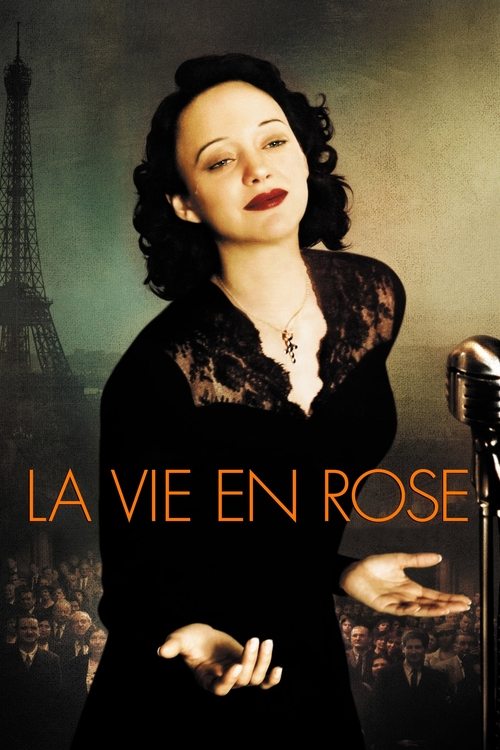
La Vie en Rose
From the mean streets of the Belleville district of Paris to the dazzling limelight of New York's most famous concert halls, Edith Piaf's life was a constant battle to sing and survive, to live and love. Raised in her grandmother's brothel, Piaf was discovered in 1935 by nightclub owner Louis Leplee, who persuaded her to sing despite her extreme nervousness. Piaf became one of France's immortal icons, her voice one of the indelible signatures of the 20th century.
Dialogues from Movie La Vie en Rose
Quotes from Movie La Vie en Rose
Sound Tracks from La Vie en Rose by G. P.
La Vie en Rose
La Vie en Rose by Édith Piaf, Key song that defines the character's life and love
Les Trois Cloches
Les Trois Cloches by Les Compagnons de la Chanson, Background during a nostalgic moment in Piaf's life
Milord
Milord by Édith Piaf, Performed during a pivotal scene showcasing her rise to fame
Non, Je Ne Regrette Rien
Non, Je Ne Regrette Rien by Édith Piaf, Emotional moment reflecting on her past
Download App
Memorable Scenes from Movie La Vie en Rose
Édith's Childhood
This scene depicts young Édith Piaf living in poverty with her father, a soldier, and her mother, who is absent due to constant struggles. The sad environment shapes her future, driving her ambition to escape her circumstances through music. The pivotal moment comes when Édith’s father takes her to live with her grandmother, a significant shift in her life. This abandonment lays the groundwork for her later struggles with love and belonging. After this moment, we see how her difficult upbringing informs her choice to sing on the streets, revealing her resilience and desire for connection.
Context: This background is crucial for understanding Piaf's later fame and personal trials, as it provides insight into her motivations and emotional depth.
Singing at the Street Corner
Édith sings on a street corner in Paris, filled with passion but also vulnerability. This moment is pivotal as we see her raw talent and fierce determination, and the atmosphere is electrified with the sounds of the city. This scene captures her first audience, who are captivated by her voice. The aftermath leads to her discovery by a club owner, setting her on the path to stardom. Her performance evokes a mix of admiration and sympathy, stirring hope and joy in viewers as they witness her first steps toward recognition.
Context: This moment signifies the beginning of her rise, showcasing her ability to touch the hearts of those around her despite her struggles.
Meeting Louis Guglielmi
Édith's encounter with the composer Louis Guglielmi, better known as 'Môme', marks a romantic turning point in her life. Their immediate chemistry and bond over music highlight her longing for love and acceptance. The pivotal moment is when Louis kisses Édith, awakening feelings she had long suppressed. This scene's aftermath plunges her into a heartfelt romance. It brings laughter and sweetness, evoking warmth and the bittersweet realization of the love she desperately seeks.
Context: This meeting is significant as it brings love into her life, contrasting the loneliness of her childhood. It highlights how love fuels her artistry.
The Loss of Louis
The news of Louis’s tragic death hits Édith hard, leading to a powerful emotional breakdown. She is seen spiraling into grief, reflecting the dark shadow that love can cast. The pivotal moment is when she stands in their shared apartment, filled with memories. The scene is visually haunting, capturing her despair through close-ups and dim lighting. This aftermath changes her music and performance style, leading her to darker themes. It strikes viewers with its raw emotion, leaving them feeling her heartbreak profoundly.
Context: This moment shows the fragility of love in Édith's life and emphasizes the theme of loss that pervades her story.
Performing 'La Vie en Rose'
Édith takes the stage to perform her signature song, 'La Vie en Rose'. The atmosphere is electric as she pours her heart into the performance. This moment represents her triumph, where her artistry reaches its zenith, reconnecting her with joy and passion. The combination of her heartfelt delivery and the emotional visuals creates a memorable experience for the audience. The aftermath sees her becoming a superstar, but this achievement comes with the burden of her earlier losses, evoking pride mixed with melancholy in viewers.
Context: The performance encapsulates her journey from despair to glory, showcasing how music becomes her salvation.
The Arrival of Fame
As Édith rises to fame, we see her overwhelmed by the attention. The bright lights and strong fanfare contrast sharply with her more modest beginnings. The pivotal moment occurs when she realizes that recognition comes with scrutiny and loss of privacy. The celebration quickly turns into isolation. The emotional weight of this gives viewers a sense of empathy for her, understanding the price of fame as she navigates her new reality.
Context: This symbolizes the complexities of success, as her personal life becomes a collateral damage in the face of her new career.
Reunion with Her Father
Édith unexpectedly meets her estranged father after many years. There's a mix of emotions—joy, anger, and unresolved pain. The pivotal moment comes when she confronts him about her childhood. The tension is palpable, and the dialogue is charged with feelings of abandonment and longing. This reconciliation drives Édith to reflect on her past choices, illustrating the intricate relationships that shape her. Viewers are left feeling a mix of catharsis and sadness, balancing the complexity of familial bonds.
Context: This reunion adds depth to her character, showcasing how unresolved issues from her past continue to influence her present.
Love with Marcel Cerdan
The romantic relationship between Édith and boxer Marcel Cerdan is depicted with passion and intensity. Their chemistry is palpable, and this moment highlights how love revitalizes her spirit. The pivotal moment arises during a passionate encounter when Marcel promises to support her dreams. This brings a sense of hope, but the bittersweet nature of their relationship foreshadows impending tragedy. Viewers feel a mix of joy and trepidation, acutely aware of the vulnerability of love.
Context: Their relationship exemplifies the duality of love—its ability to inspire and the pain that can accompany joy.
Marcel's Tragic Death
Édith receives news of Marcel’s fatal plane crash, and we witness her devastation unfold. The pivotal moment shows her breaking down, shouting his name in despair. The visuals are heart-wrenching, with rain pouring down, amplifying her anguish. This loss profoundly impacts her, as seen in her performances post-tragedy. Viewers are hit with a wave of sorrow, recognizing how the loss redefines her existence and artistry.
Context: This scene encapsulates the theme of love and loss, emphasizing the unforgiving nature of fate in her life.
Édith's Return to the Stage
In a moment of vulnerability, Édith returns to the stage to sing after losing Marcel. Her performance is hauntingly beautiful, filled with raw emotion. The pivotal moment comes when she breaks down mid-song, revealing her pain. The audience holds its breath, collectively witnessing her struggle. The aftermath of this moment symbolizes her resilience and the power of art as a coping mechanism. It evokes strong emotions—pride for her bravery and deep sorrow for her loss.
Context: This return highlights how art can serve as both an escape and a confrontation with one’s deepest fears.
A Moment of Reflection
Édith sits alone in her dressing room, reflecting on her life after a performance. This quiet moment shows her vulnerable side, grappling with her past and present. The pivotal moment occurs as she stares at her own reflection, contemplating her identity beyond fame. This introspection leads to a deeper understanding of her struggles with self-worth. The silence is heavy, leaving viewers in a contemplative mood, resonating with the quest for authenticity in one’s life.
Context: This scene emphasizes the isolation that often accompanies fame, exploring the duality of her public and private persona.
Confrontation with Her Manager
Édith has a heated argument with her manager, who pressures her to perform despite her emotional turmoil. The pivotal moment comes when she asserts her need for a break, showing her determination to put her mental health first. The dialogue is sharp, filled with tension, highlighting her struggle against the demands of fame. The aftermath proves empowering, as she prioritizes her mental well-being. This evokes admiration from viewers, illustrating the importance of self-care amid chaos.
Context: This confrontation serves as a pivotal realization of her agency, asserting independence in an industry that often demands compliance.
Dream Sequence
A dream sequence where Édith envisions a world free of her troubles. Bright colors replace the somber tones of her reality, and she sings joyfully among friends. The pivotal moment comes when the dream shatters, and she wakes up to her harsh reality. This visual contrast is striking. Viewers experience a mix of joy and melancholy, grasping the fragility of happiness in her world.
Context: This sequence captures the yearning for a simpler, happier existence, underscoring the overarching theme of hope amidst despair.
The Farewell Concert
In her final concert, Édith reflects on her life and the people she lost. This moment peaks when she sings a goodbye song filled with emotion; the crowd is silent, captivated. The visuals are poignant, capturing the weight of her memories. This farewell marks the end of an era, and the aftermath sees her embracing a new chapter. Viewers are left feeling a mix of sorrow and gratitude for her openness, recognizing lifelong struggles and triumphs.
Context: This concert embodies her legacy, tying up the narrative of a life full of inspiration and hardship.
The Final Scene
The film closes with Édith standing alone, contemplating her life and music. The visuals capture her in solitude, yet there’s a peacefulness in her expression, signifying acceptance. The pivotal moment comes as she smiles softly, acknowledging her journey. This moment resonates deeply with viewers, evoking a sense of closure and reflection on the complexity of her character. It leaves an impactful question about the meaning of fulfillment.
Context: The final scene encapsulates her growth and self-acceptance, inviting viewers to reflect on their lives and dreams.
Édith as a Mother Figure
Édith takes on a maternal role towards a young girl she mentors. This nurturing moment highlights her softer side and desire to give back. The pivotal moment comes when she offers words of wisdom, guiding the girl through her own struggles. This interaction showcases Édith’s growth, as she learns to channel her pain into helping others. Viewers feel warmth and admiration, witnessing her transformation into a guiding presence.
Context: This moment reveals her capacity for empathy and connection, emphasizing the importance of mentorship and compassion.
Friendship with Simone
Édith’s friendship with Simone blossoms, showcasing lighter moments filled with laughter. This pivotal scene offers a welcome respite from her darker storylines. Their banter and support highlight the power of friendship through hardship. The aftermath reveals how these connections bolster her resilience. Viewers smile, feeling uplifted by the joy and camaraderie shared between them.
Context: This friendship emphasizes the theme of companionship, showing how vital relationships enrich one’s journey.
The Importance of Heritage
Édith revisits her childhood neighborhood, reflecting on her roots. The pivotal moment is her emotional response to her past surroundings as she recalls memories tied to her family. This realization fuels her passion for music. Viewers sense a strong connection to her origins, understanding how her heritage influences her artistry deeply.
Context: This moment is significant as it reinforces the theme of identity, exploring how her background shapes her music and character.
Édith in Recovery
After a health scare, Édith undergoes rehabilitation, showcasing her vulnerability. The pivotal moment comes when she admits her fears about her future. The raw honesty influences her character trajectory, displaying her perseverance. This scene elicits sympathy and a desire to support her, highlighting the human struggles every artist faces.
Context: This moment reveals the fragility of health and the resilience required to overcome personal adversity, emphasizing the importance of mental well-being.
Facing Criticism
Édith confronts harsh criticism from a journalist about her latest performance. The pivotal moment is her passionate defense of her art, showcasing her belief in authenticity above all. This confrontation empowers her character, turning an attack into a moment of self-affirmation. Viewers feel pride in her resilience and appreciation for her dedication to her craft.
Context: This scene underlines the pressures artists face from the public and the importance of staying true to oneself amidst external opinions.
The Reunion with Old Friends
Édith reunites with old friends, reminiscing about their shared past. The warmth and nostalgia of the moment create a heartfelt atmosphere. The pivotal moment comes when they share stories that reveal the depth of their bond, resonating with long-standing friendships. The aftermath showcases the power of support through time. Viewers experience joy mixed with nostalgia, reminding them of the importance of friendships.
Context: This scene illustrates how relationships endure and shape one’s identity, emphasizing the ties to the past that remain relevant.
A Surprise Performance
Édith performs a surprise song at a local café, showcasing her unpretentious side amidst her fame. The audience’s genuine reaction adds warmth to the moment. The pivotal point comes when she immerses herself in the music, free from the weight of expectations. This aftermath reveals her continuous connection to her art. Viewers feel uplifted and reminded of the joy that comes from sharing music for its sake.
Context: This scene captures her love for music and illustrates the joy of performing in an intimate setting, parallel to her public persona.
Édith’s Confession
In a deeply personal moment, Édith confesses her insecurities and fears to a close friend. The pivotal moment arrives when she acknowledges that her fame feels isolating, marking a breakthrough in her character development. The heartfelt conversation resonates with audiences, evoking empathy and understanding. This moment reinforces her complexity, encompassing strength and vulnerability.
Context: The confession highlights the internal battles artists endure, emphasizing mental health's vital role in an artist’s life.
End of an Era
In a reflective moment, Édith leaves the stage for the last time. The audience's emotional response is palpable, illustrating the depth of her impact. The pivotal moment occurs when she turns to say goodbye; her expression conveys a lifetime of experiences. This aftermath symbolizes closure, a culmination of her journey. Viewers are left in a state of bittersweet nostalgia, recognizing the significance of her departure.
Context: This scene encapsulates the end of an influential chapter, tying together her trials and triumphs, and marking a transition in her legacy.
Legacy of Love
The film concludes with images of her life and career, intermixed with scenes of people inspired by her story. This moment crystallizes her legacy, showing how her music transcends personal tragedies. The pivotal moment is the emotional impact on her audience, proving her influence is everlasting. This aftermath reflects on the broader impact of her work. Audiences feel a sense of gratitude and appreciation for her artistry, understanding the universal themes she represented.
Context: This final montage encapsulates the film’s themes of love, loss, and resilience, leaving a lasting impression of Édith Piaf’s remarkable journey.
Download App








